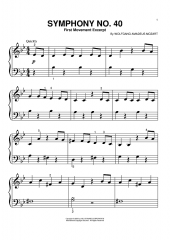![]()
![]()
![]()
Use LEFT and RIGHT arrow keys to navigate between flashcards;
Use UP and DOWN arrow keys to flip the card;
H to show hint;
A reads text to speech;
23 Cards in this Set
- Front
- Back
|
What is the piece called, which movement are we studying, when was it composed and who was it composed by? |
- Symphony no.40 in G minor - 1st movement - 1788 - Wolfgang Amadeus Mozart
|
|
|
Roughly when was the Classical Era and what were its typical features? |
1750 - 1810/30 - simple, well proportioned and graceful melodic lines - periodic phrasing (equal phrases), often in a question and answer form - texture is usually melody-dominated homophony (homophonic texture in which melody is most important) - clear balanced structure - clear keys and regular cadences - functional harmony - lots of chords I, IV and V - orchestra - standard ensemble, harpsichord no longer used - new genres emerged - concertos, symphonies, string quartets etc - mainly simple diatonic harmony - using notes that belong to the key rather than using chromatic notes outside the key - use of contrasting moods |
|
|
Who were the key classical composers? |
Mozart, Hadyn and Beethoven |
|
|
Define Symphony: |
a large scale work for orchestra with 4 movements - it was one of the most popular large-scale genres invented during the classical era |
|
|
Describe the movements in a symphony: |
- 1st movement - fast tempo, usually in sonata form (we're studying mozart's 1st movement) - 2nd movement - slow tempo, various structures used - 3rd movement - minuet and trio, or scherzo and trio - 4th movement - fast, usually rondo or sonata form |
|
|
Define Sonata form: |
a structure invented during the Classical era consisting of 3 sections: exposition, development and recapitulation |
|
|
Describe the features of each section of sonata form and which bar numbers they are from in this piece: |
Exposition: 1st subject is introduced in the tonic key, 2nd subject is later introduced in a different but related key, bars 1-100 Development: ideas from the exposition are developed, and there are modulations to various keys, bars 101-164 Recapitulation: recap of the exposition featuring the 1st subject and 2nd subject, this time both in the tonic key as the work draws to a close; there may be a short coda to end, bars 165-299 |
|
|
Describe the piece's instrumentation: |
- Mozart writes for quite a small orchestra - there are 7 woodwind players, 2 horns and a string quartet - he doesn't use any trumpets or percussion,as usually found in a classical orchestra |
|
|
Describe the tempo and key of this piece: |
- tempo - molto allegro (fast) - key - G minor |
|
|
Describe the melody and harmony in this piece: |
- melody - 1st subject in G minor, 2nd subject in Bb major (relative major) in exposition; both subjects in G minor for recapitulation; chromatic melodies are used - harmony - use of pedal notes (e.g. bar 16-20, strings play a dominant pedal on D); lots of perfect cadences and functional harmony chords (I, IV and V) |
|
|
Describe the Rhythms and Dynamics used: |
- rhythm - mainly crotchets and quavers; use of augmentation and diminution - contrasting dynamics - piano and forte |
|
|
How might Mozart develop a theme? |
- modulation - repetition - chromatic alteration - development of rhythmic figurations |
|
|
What musical device do the horn and bassoon play? |
a pedal note |
|
|
Where and when was Mozart born and where and when did he die? |
Born: January 27, 1756, Salzburg, Austria Died: December 5, 1791, Vienna, Austria |
|
|
What is the interval between the violins playing subject 1?
|
an octave
|
|
|
Which two instrumental families is the 2nd subject shared between?
|
strings and woodwind
|
|
|
Which 3 instruments play the 3 note motif in the development section?
|
violin, clarinet and flute
|
|
|
Describe the notes played by the violin in the 1st theme:
|

|
|
|
Describe the notes played in the 2nd theme:
|

|
|
|
Go on youtube and listen to 'Mozart Symphony #40 in G minor K550 - 1. Molto Allegro' from 0:53 to 1:21; which section of the piece is this? |
the exposition section |
|
|
Describe the structure of this piece: |
- is sonata form and has 3 main sections - these sections: exposition, development and recapitulation and a short coda |
|
|
Describe the texture of the piece: |
- many contrapuntal textures in the development and recapitulation and also use of imitation - overall the piece is homophonic and melody and accompaniment - thick textures created often when all of the instruments play |
|
|
Describe the use of wind instruments in this piece: |
- wind instruments featuring in the piece are the flute, two oboes, two clarinets and two bassoons - second subject passes between the strings and woodwind (clarinets and bassoons) - woodwind uses ornaments e.g. trills |

